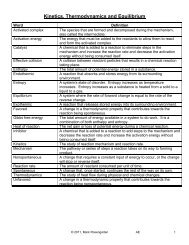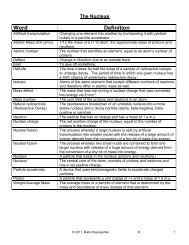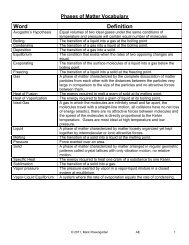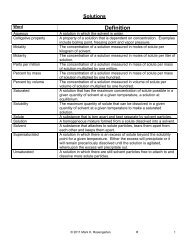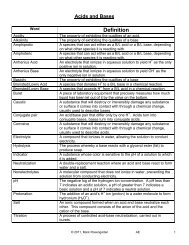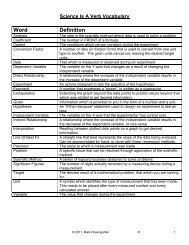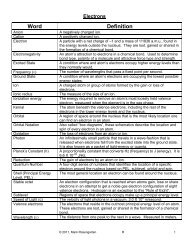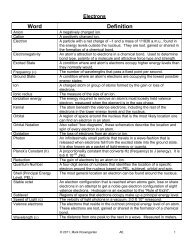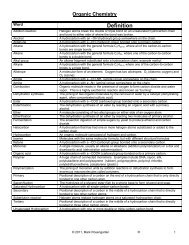Unit 4 - Mark Rosengarten
Unit 4 - Mark Rosengarten
Unit 4 - Mark Rosengarten
Create successful ePaper yourself
Turn your PDF publications into a flip-book with our unique Google optimized e-Paper software.
Countries with very little oil of their own (like France and Japan) have two choices. They can either import oil (which is<br />
not good for the economy) or find another way to generate it. These countries have found an alternate energy source<br />
with which to produce electricity: nuclear power. This uses a nuclear fission reaction instead of burning oil or coal to<br />
produce the heat necessary to turn water to pressurized steam (which turns the turbine which turns the generator).<br />
Nuclear power never caught on in this country to the extent that it has in France and Japan. Though 20% of our<br />
electricity is generated by nuclear power plants, the general public has generally been unfavorable to nuclear power.<br />
They fear an accident like the 1986 Chernobyl reactor meltdown that rendered thousands of square miles of<br />
countryside in the Ukraine uninhabitable. The fact is, the Russians underbuilt their power plants to save money. Our<br />
power plants are built with regulated safeguards that make an accident (and resulting devastation) like Chernobyl<br />
virtually impossible. Another concern is the possibility of a terrorist attack. Nuclear power plant containment structures<br />
are built with multiple layers of protection, and can withstand the impact of a large airplane. Also contrary to “popular”<br />
belief, a nuclear power plant CANNOT undergo a nuclear explosion like a bomb. It is physically impossible.<br />
Nuclear power plants do produce waste products that are extremely compact and are contained within the reactor.<br />
What to do with these wastes has been a matter of much debate. New technologies are emerging which will allow the<br />
reuse of waste products, reducing their volume even further.<br />
There is a movement underway to build new, updated nuclear power plants here in the <strong>Unit</strong>ed States. This would<br />
bring “green” electricity to more people, allowing cars to become electric and rechargeable (especially commuter cars)<br />
and cutting down significantly on the amount of carbon dioxide we are currently putting into the atmosphere. It will also<br />
cut down on our dependence on a resource in dwindling supply, and our dependence on other countries to provide us<br />
with it. We have a whole fleet of nuclear-powered submarines and aircraft carriers that have operated flawlessly for<br />
decades. Are you ready for a little nuclear power in your life? Too late! You’ve already got it! Time for more? You<br />
decide! This will involve a research project at the end so you can decide for yourself if nuclear power is for you!<br />
NUCLEAR FISSION – A few nuclei larger than Fe-56 can be split into smaller nuclei, destroying a tiny bit of mass and<br />
creating vast amounts of energy. Nuclear fission produces, gram for gram, thousands of times more energy than<br />
burning fossil fuels.<br />
NUCLEAR FISSION REACTORS (Like the one at Indian Point, which generates electricity for Orange & Rockland as<br />
well as Central Hudson customers) - operate on the following reaction:<br />
235<br />
92 U + 1 0n 92 36Kr + 141 56Ba + 3 1 0n + energy<br />
U-235 is the FISSIONABLE FUEL. It is found in the reactor in the form of uranium oxide pellets, sealed into FUEL<br />
RODS. When nuclei of U-235 are hit by a SLOW-MOVING NEUTRON, the nucleus absorbs the neutron and splits<br />
apart into TWO SMALLER NUCLEI (usually of different sizes). The split also releases 2 or 3 (depending on what the<br />
two smaller nuclei were) FAST-MOVING NEUTRONS, which, if you can slow them down, can be used to split even<br />
more U-235 nuclei. This process destroys a tiny bit of mass, producing huge amounts of energy.<br />
In order to slow the fast-moving neutrons down so that more U-235 nuclei can absorb them, the fuel rods are placed<br />
into a MODERATOR, a material that can slow the neutrons down without stopping them. In the <strong>Unit</strong>ed States, water is<br />
used as a moderator. This is convenient, because the water also acts as a coolant in the case of an emergency. The<br />
Chernobyl reactor used a moderator made of graphite, which does the job, but is a solid and has no cooling properties.<br />
Graphite is found in your pencil, it’s crystalline carbon.<br />
As more and more U-235 nuclei are split, even more neutrons are released. This produces a CHAIN REACTION,<br />
which can get out of control and cause the U-235 to heat up enough to melt. Molten U-235 can melt its way right<br />
through the reactor’s containment structure, which is what happened in Chernobyl. In 1979, the Three Mile Island<br />
nuclear power plant near Harrisburg, Pennsylvania, had a partial meltdown, but the multiple levels of containment kept<br />
the radioactive material from escaping. To control the flow of neutrons, CONTROL RODS can be inserted between<br />
the fuel rods. These are made of steel alloys that have very high melting points, and can absorb neutrons without<br />
becoming radioactive themselves. To slow the chain reaction down, the rods are pushed further down between the<br />
fuel rods, and to speed the reaction up, the rods are raised until the desired temperature is reached. In the event of an<br />
emergency, or if the reactor needs to be shut down for maintenance (like refueling the reactor), the control rods drop<br />
all the way down, cutting off all of the neutrons flying between the fuel rods and stopping the reaction completely. This<br />
mechanism was defective in the Chernobyl plant, leading to a meltdown and a pressure-induced explosion.<br />
© 2011, <strong>Mark</strong> <strong>Rosengarten</strong> AE 16



